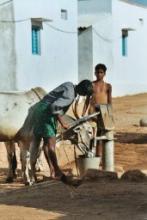India: Linking Water Supply and Poverty Alleviation
India: Linking Water Supply and Poverty Alleviation
| Title | India: Linking Water Supply and Poverty Alleviation |
| Publication Type | Study report |
| Year of Publication | Submitted |
| Authors | Verhagen J., James A.J., van Wijk-Sijbesma C.A., Nanavatty R., Parikh M., Bath M. |
| Publication Language | eng |
| Abstract | The conventional objectives of domestic water supply projects are improved welfare and public health. However, having more water close to the home also has the potential to deliver significant economic benefits. Entitled 'Linking water supply and poverty evaluation: the impact of women’s productive use of water and time on household economy and gender relations in Banaskantha District, Gujarat, India', this report investigates the opportunities and impacts of water service delivery to households. |
| Citation Key | 90 |
| Full Text | Joep Verhagen, A.J. James, Christine van Wijk, Reema Nanavatty, Mita Parikh, Mihir Bhatt (2004) In general, women continue to have limited opportunities to influencing the design and operations of domestic water supply projects for their productive use of water and time. This report describes the findings of a pilot research project carried out in Gujarat, India. Together with the women and men of Gujarat, the relevance of women's productive use of water, the time gains for the family, the impact of such uses on gender relations, and the implications for policies, project design and operations management are among the issues that were examined. The full report is available for download from the IRC website. The study was carried out from June 1999 to April 2001 by the Foundation for Public Interest (FPI), the Self-Employed Women's Association (SEWA), and the IRC International Water and Sanitation Centre. The Swedish International Development Authority (Sida) financed the research. |

